SKODA YETI 2014 1.G / 5L Owner's Manual
Manufacturer: SKODA, Model Year: 2014, Model line: YETI, Model: SKODA YETI 2014 1.G / 5LPages: 248, PDF Size: 29.49 MB
Page 221 of 248
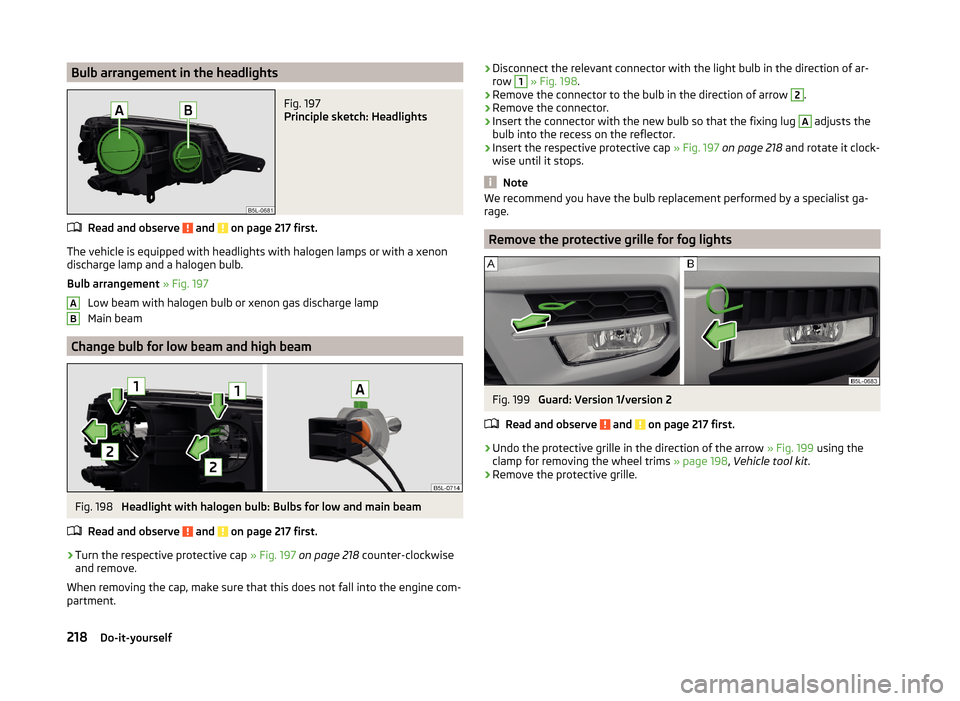
Bulb arrangement in the headlightsFig. 197
Principle sketch: Headlights
Read and observe and on page 217 first.
The vehicle is equipped with headlights with halogen lamps or with a xenon
discharge lamp and a halogen bulb.
Bulb arrangement » Fig. 197
Low beam with halogen bulb or xenon gas discharge lamp
Main beam
Change bulb for low beam and high beam
Fig. 198
Headlight with halogen bulb: Bulbs for low and main beam
Read and observe
and on page 217 first.
›
Turn the respective protective cap » Fig. 197 on page 218 counter-clockwise
and remove.
When removing the cap, make sure that this does not fall into the engine com-
partment.
AB› Disconnect the relevant connector with the light bulb in the direction of ar-
row 1 » Fig. 198 .›
Remove the connector to the bulb in the direction of arrow
2
.
›
Remove the connector.
›
Insert the connector with the new bulb so that the fixing lug
A
adjusts the
bulb into the recess on the reflector.
›
Insert the respective protective cap » Fig. 197 on page 218 and rotate it clock-
wise until it stops.
Note
We recommend you have the bulb replacement performed by a specialist ga-
rage.
Remove the protective grille for fog lights
Fig. 199
Guard: Version 1/version 2
Read and observe
and on page 217 first.
›
Undo the protective grille in the direction of the arrow » Fig. 199 using the
clamp for removing the wheel trims » page 198, Vehicle tool kit .
›
Remove the protective grille.
218Do-it-yourself
Page 222 of 248
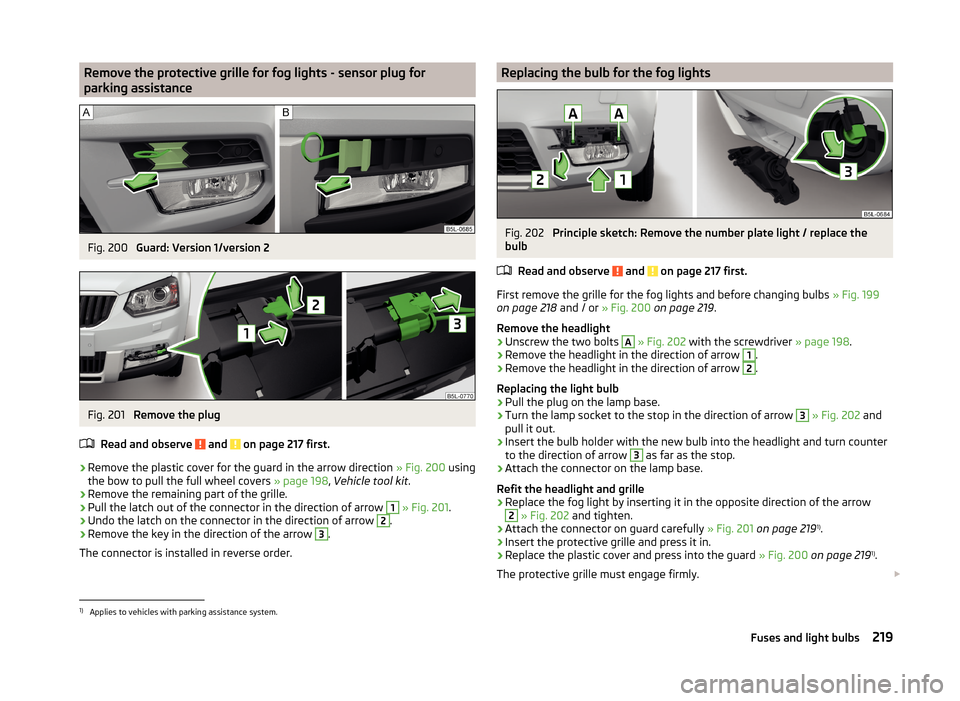
Remove the protective grille for fog lights - sensor plug for
parking assistanceFig. 200
Guard: Version 1/version 2
Fig. 201
Remove the plug
Read and observe
and on page 217 first.
›
Remove the plastic cover for the guard in the arrow direction » Fig. 200 using
the bow to pull the full wheel covers » page 198, Vehicle tool kit .
›
Remove the remaining part of the grille.
›
Pull the latch out of the connector in the direction of arrow
1
» Fig. 201 .
›
Undo the latch on the connector in the direction of arrow
2
.
›
Remove the key in the direction of the arrow
3
.
The connector is installed in reverse order.
Replacing the bulb for the fog lightsFig. 202
Principle sketch: Remove the number plate light / replace the
bulb
Read and observe
and on page 217 first.
First remove the grille for the fog lights and before changing bulbs » Fig. 199
on page 218 and / or » Fig. 200 on page 219 .
Remove the headlight
›
Unscrew the two bolts
A
» Fig. 202 with the screwdriver » page 198.
›
Remove the headlight in the direction of arrow
1
.
›
Remove the headlight in the direction of arrow
2
.
Replacing the light bulb
›
Pull the plug on the lamp base.
›
Turn the lamp socket to the stop in the direction of arrow
3
» Fig. 202 and
pull it out.
›
Insert the bulb holder with the new bulb into the headlight and turn counter
to the direction of arrow
3
as far as the stop.
›
Attach the connector on the lamp base.
Refit the headlight and grille
›
Replace the fog light by inserting it in the opposite direction of the arrow
2
» Fig. 202 and tighten.
›
Attach the connector on guard carefully » Fig. 201 on page 219 1)
.
›
Insert the protective grille and press it in.
›
Replace the plastic cover and press into the guard » Fig. 200 on page 219 1)
.
The protective grille must engage firmly.
1)
Applies to vehicles with parking assistance system.
219Fuses and light bulbs
Page 223 of 248
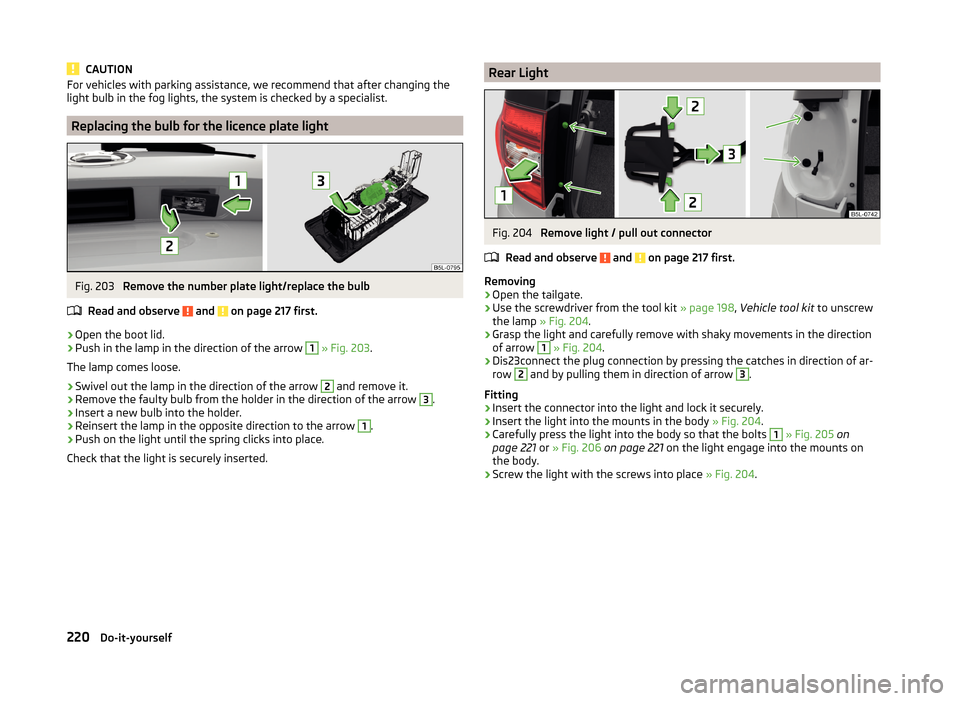
CAUTIONFor vehicles with parking assistance, we recommend that after changing the
light bulb in the fog lights, the system is checked by a specialist.
Replacing the bulb for the licence plate light
Fig. 203
Remove the number plate light/replace the bulb
Read and observe
and on page 217 first.
›
Open the boot lid.
›
Push in the lamp in the direction of the arrow
1
» Fig. 203 .
The lamp comes loose.
›
Swivel out the lamp in the direction of the arrow
2
and remove it.
›
Remove the faulty bulb from the holder in the direction of the arrow
3
.
›
Insert a new bulb into the holder.
›
Reinsert the lamp in the opposite direction to the arrow
1
.
›
Push on the light until the spring clicks into place.
Check that the light is securely inserted.
Rear LightFig. 204
Remove light / pull out connector
Read and observe
and on page 217 first.
Removing
›
Open the tailgate.
›
Use the screwdriver from the tool kit » page 198, Vehicle tool kit to unscrew
the lamp » Fig. 204 .
›
Grasp the light and carefully remove with shaky movements in the direction
of arrow
1
» Fig. 204 .
›
Dis23connect the plug connection by pressing the catches in direction of ar-
row
2
and by pulling them in direction of arrow
3
.
Fitting
›
Insert the connector into the light and lock it securely.
›
Insert the light into the mounts in the body » Fig. 204.
›
Carefully press the light into the body so that the bolts
1
» Fig. 205 on
page 221 or » Fig. 206 on page 221 on the light engage into the mounts on
the body.
›
Screw the light with the screws into place » Fig. 204.
220Do-it-yourself
Page 224 of 248
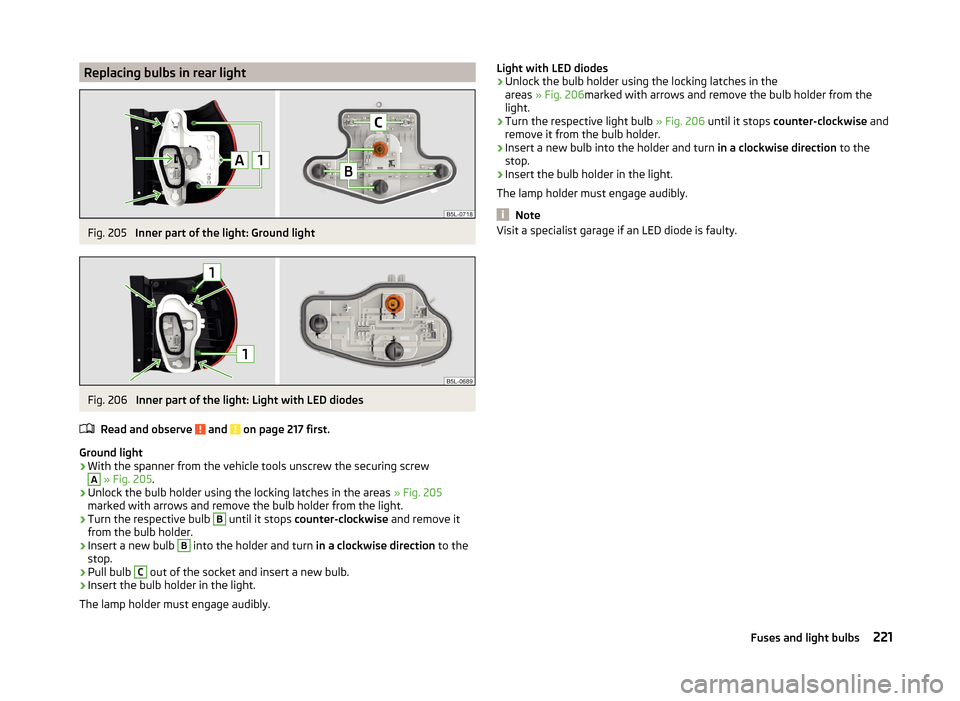
Replacing bulbs in rear lightFig. 205
Inner part of the light: Ground light
Fig. 206
Inner part of the light: Light with LED diodes
Read and observe
and on page 217 first.
Ground light
›
With the spanner from the vehicle tools unscrew the securing screw
A
» Fig. 205 .
›
Unlock the bulb holder using the locking latches in the areas » Fig. 205
marked with arrows and remove the bulb holder from the light.
›
Turn the respective bulb
B
until it stops counter-clockwise and remove it
from the bulb holder.
›
Insert a new bulb
B
into the holder and turn in a clockwise direction to the
stop.
›
Pull bulb
C
out of the socket and insert a new bulb.
›
Insert the bulb holder in the light.
The lamp holder must engage audibly.
Light with LED diodes›Unlock the bulb holder using the locking latches in the
areas » Fig. 206 marked with arrows and remove the bulb holder from the
light.›
Turn the respective light bulb » Fig. 206 until it stops counter-clockwise and
remove it from the bulb holder.
›
Insert a new bulb into the holder and turn in a clockwise direction to the
stop.
›
Insert the bulb holder in the light.
The lamp holder must engage audibly.
Note
Visit a specialist garage if an LED diode is faulty.221Fuses and light bulbs
Page 225 of 248
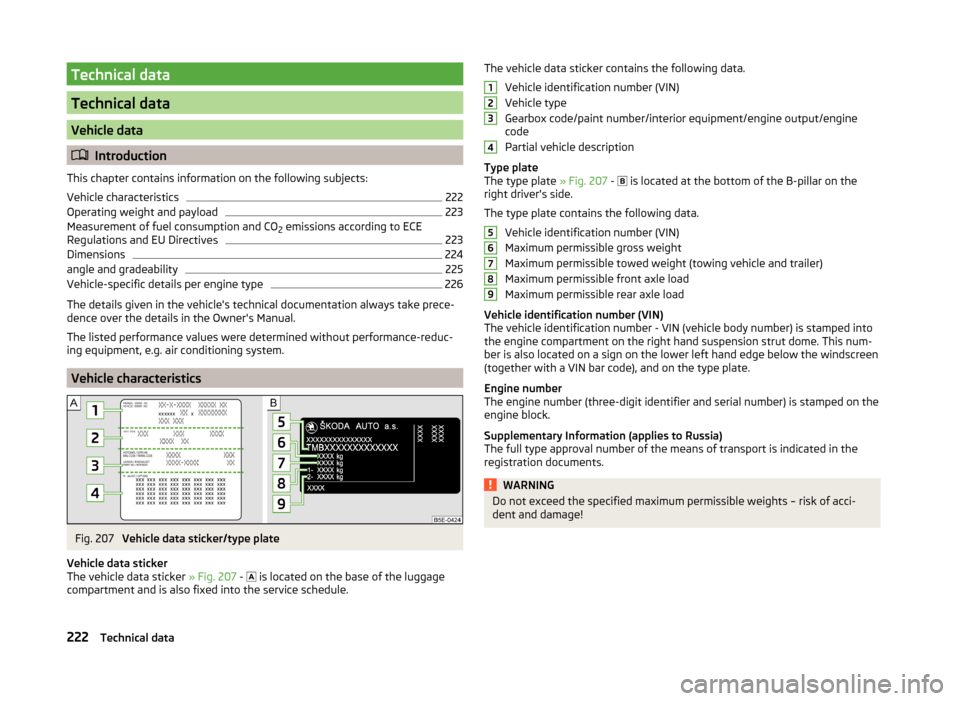
Technical data
Technical data
Vehicle data
Introduction
This chapter contains information on the following subjects:
Vehicle characteristics
222
Operating weight and payload
223
Measurement of fuel consumption and CO 2 emissions according to ECE
Regulations and EU Directives
223
Dimensions
224
angle and gradeability
225
Vehicle-specific details per engine type
226
The details given in the vehicle's technical documentation always take prece-
dence over the details in the Owner's Manual.
The listed performance values were determined without performance-reduc- ing equipment, e.g. air conditioning system.
Vehicle characteristics
Fig. 207
Vehicle data sticker/type plate
Vehicle data sticker
The vehicle data sticker » Fig. 207 -
is located on the base of the luggage
compartment and is also fixed into the service schedule.
The vehicle data sticker contains the following data.
Vehicle identification number (VIN)
Vehicle type
Gearbox code/paint number/interior equipment/engine output/engine
code
Partial vehicle description
Type plate
The type plate » Fig. 207 -
is located at the bottom of the B-pillar on the
right driver's side.
The type plate contains the following data. Vehicle identification number (VIN)
Maximum permissible gross weight
Maximum permissible towed weight (towing vehicle and trailer)
Maximum permissible front axle load
Maximum permissible rear axle load
Vehicle identification number (VIN)
The vehicle identification number - VIN (vehicle body number) is stamped into
the engine compartment on the right hand suspension strut dome. This num-
ber is also located on a sign on the lower left hand edge below the windscreen
(together with a VIN bar code), and on the type plate.
Engine number
The engine number (three-digit identifier and serial number) is stamped on the engine block.
Supplementary Information (applies to Russia)
The full type approval number of the means of transport is indicated in the
registration documents.WARNINGDo not exceed the specified maximum permissible weights – risk of acci-
dent and damage!123456789222Technical data
Page 226 of 248

Operating weight and payload
Operating weight
This value represents the minimum operating weight without additional
weight-increasing equipment such as air conditioning system, spare wheel, or
trailer hitch.
The specified operating weight is for orientation purposes only.
The operating weight also contains the weight of the driver (75 kg), the weight
of the operating fluids, the tool kit, and a fuel tank filled to 90 % capacity.
Operating weight of the vehicle » page 226.
Payload
It is possible to calculate the approximate maximum payload from the differ-
ence between the permissible total weight and the operating weight.
The payload consists of the following weights.
› The weight of the passengers.
› The weight of all items of luggage and other loads.
› The weight of the roof, including the roof rack system.
› The weight of the equipment that is excluded from the operating weight.
› The trailer nose weight with trailer (max. 80 kg and 85 kg 1)
).
Note
If required, you can find out the precise weight of your vehicle at a specialist
garage.
Measurement of fuel consumption and CO 2 emissions according to
ECE Regulations and EU Directives
The data on fuel consumption and CO 2 emissions were not available at the
time of going to press.
The data on fuel consumption and CO 2 emissions are given on the ŠKODA
websites or in the sales and technical vehicle documentation.
The measurement of the intra-urban cycle begins with a cold start of the en-
gine. Afterwards urban driving is simulated.
In the extra-urban driving cycle, the vehicle is accelerated and decelerated in
all gears, corresponding to daily routine driving conditions. The driving speed
varies between 0 and 120 km/h.
The calculation of the combined fuel consumption considers a weighting of
about 37 % for the intra-urban cycle and 63 % for the extra-urban cycle.
Note
■ The fuel consumption and emission levels given on the ŠKODA websites or in
the commercial and technical vehicle documentation have been established in
accordance with rules and under conditions that are set out by legal or techni-
cal rules for the determination of operational and technical data of motor vehi-
cles.■
Depending on the extent of the equipment, the driving style, traffic condi-
tions, weather influences and vehicle condition, consumption values can in
practice result in fuel economy figures in the use of the vehicle that differ from
the fuel consumption values listed on the ŠKODA websites or in the commer-
cial and technical vehicle documentation.
1)
Applies to vehicles 4x4 with the 2.0 l/103 kW TDI CR and 2.0 L/125 kW TDI CR engine.
223Technical data
Page 227 of 248
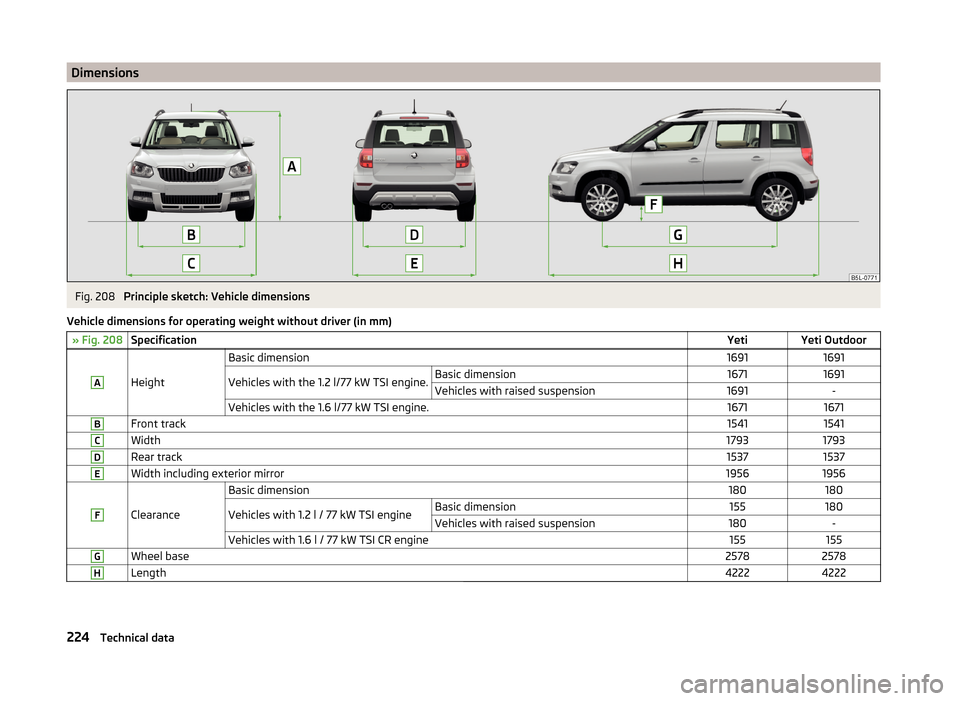
DimensionsFig. 208
Principle sketch: Vehicle dimensions
Vehicle dimensions for operating weight without driver (in mm)
» Fig. 208SpecificationYetiYeti OutdoorA
Height
Basic dimension16911691Vehicles with the 1.2 l/77 kW TSI engine.Basic dimension16711691Vehicles with raised suspension1691-Vehicles with the 1.6 l/77 kW TSI engine.16711671BFront track15411541CWidth17931793DRear track15371537EWidth including exterior mirror19561956F
Clearance
Basic dimension180180Vehicles with 1.2 l / 77 kW TSI engineBasic dimension155180Vehicles with raised suspension180-Vehicles with 1.6 l / 77 kW TSI CR engine155155GWheel base25782578HLength42224222224Technical data
Page 228 of 248
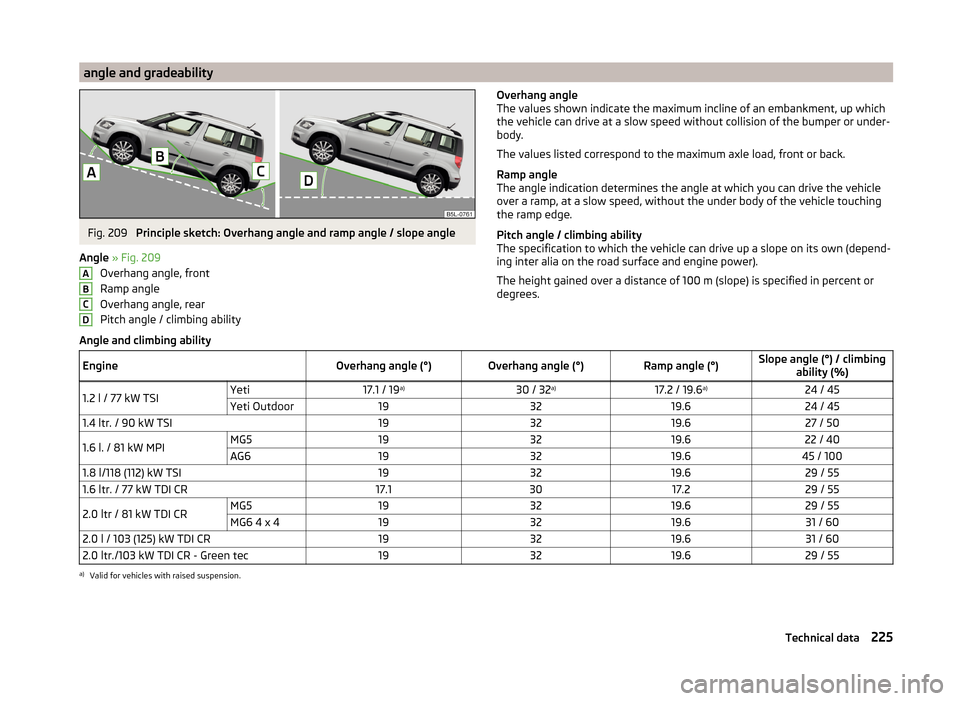
angle and gradeabilityFig. 209
Principle sketch: Overhang angle and ramp angle / slope angle
Angle » Fig. 209
Overhang angle, front
Ramp angle
Overhang angle, rear
Pitch angle / climbing ability
ABCDOverhang angle
The values shown indicate the maximum incline of an embankment, up which
the vehicle can drive at a slow speed without collision of the bumper or under-
body.
The values listed correspond to the maximum axle load, front or back.
Ramp angle
The angle indication determines the angle at which you can drive the vehicle
over a ramp, at a slow speed, without the under body of the vehicle touching
the ramp edge.
Pitch angle / climbing ability
The specification to which the vehicle can drive up a slope on its own (depend-
ing inter alia on the road surface and engine power).
The height gained over a distance of 100 m (slope) is specified in percent or degrees.Angle and climbing abilityEngineOverhang angle (°)Overhang angle (°)Ramp angle (°)Slope angle (°) / climbing ability (%)1.2 l / 77 kW TSIYeti17.1 / 19a)30 / 32a)17.2 / 19.6 a)24 / 45Yeti Outdoor193219.624 / 451.4 ltr. / 90 kW TSI193219.627 / 501.6 l. / 81 kW MPIMG5193219.622 / 40AG6193219.645 / 1001.8 l/118 (112) kW TSI193219.629 / 551.6 ltr. / 77 kW TDI CR17.13017.229 / 552.0 ltr / 81 kW TDI CRMG5193219.629 / 55MG6 4 x 4193219.631 / 602.0 l / 103 (125) kW TDI CR193219.631 / 602.0 ltr./103 kW TDI CR - Green tec193219.629 / 55a)
Valid for vehicles with raised suspension.
225Technical data
Page 229 of 248
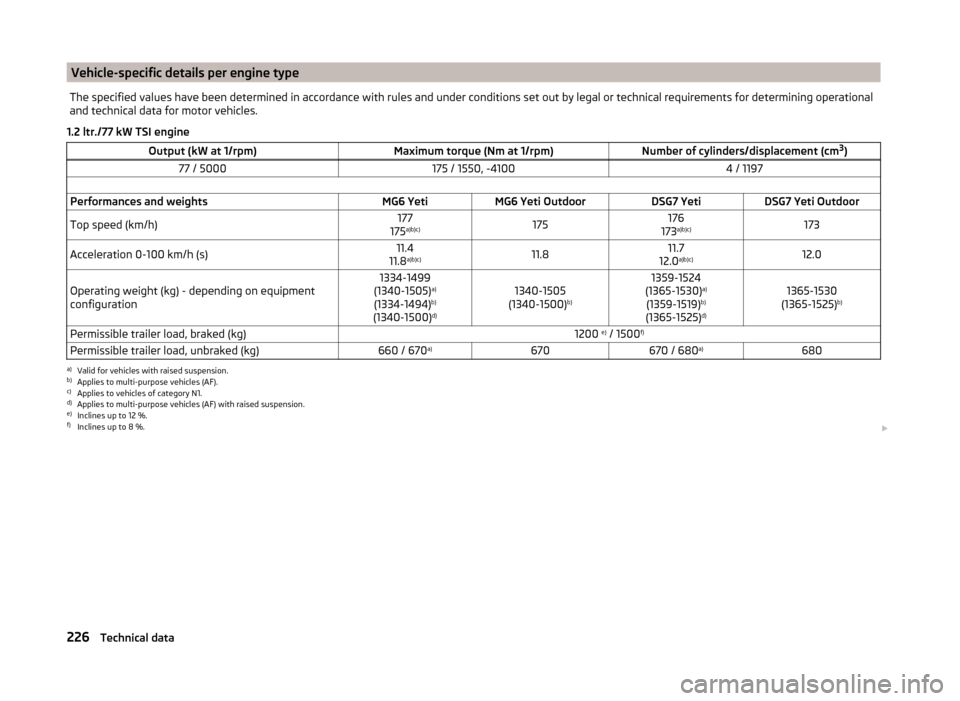
Vehicle-specific details per engine typeThe specified values have been determined in accordance with rules and under conditions set out by legal or technical requirements for determining operational
and technical data for motor vehicles.
1.2 ltr./77 kW TSI engine
Output (kW at 1/rpm)Maximum torque (Nm at 1/rpm)Number of cylinders/displacement (cm 3
)77 / 5000175 / 1550, -41004 / 1197 Performances and weightsMG6 YetiMG6 Yeti OutdoorDSG7 YetiDSG7 Yeti OutdoorTop speed (km/h)177
175 a)b)c)175176
173 a)b)c)173Acceleration 0-100 km/h (s)11.4
11.8 a)b)c)11.811.7
12.0 a)b)c)12.0Operating weight (kg) - depending on equipment
configuration1334-1499
(1340-1505) a)
(1334-1494) b)
(1340-1500) d)1340-1505
(1340-1500) b)1359-1524
(1365-1530) a)
(1359-1519) b)
(1365-1525) d)1365-1530
(1365-1525) b)Permissible trailer load, braked (kg)1200
e)
/ 1500 f)Permissible trailer load, unbraked (kg)660 / 670 a)670670 / 680 a)680a)
Valid for vehicles with raised suspension.
b)
Applies to multi-purpose vehicles (AF).
c)
Applies to vehicles of category N1.
d)
Applies to multi-purpose vehicles (AF) with raised suspension.
e)
Inclines up to 12 %.
f)
Inclines up to 8 %.
226Technical data
Page 230 of 248
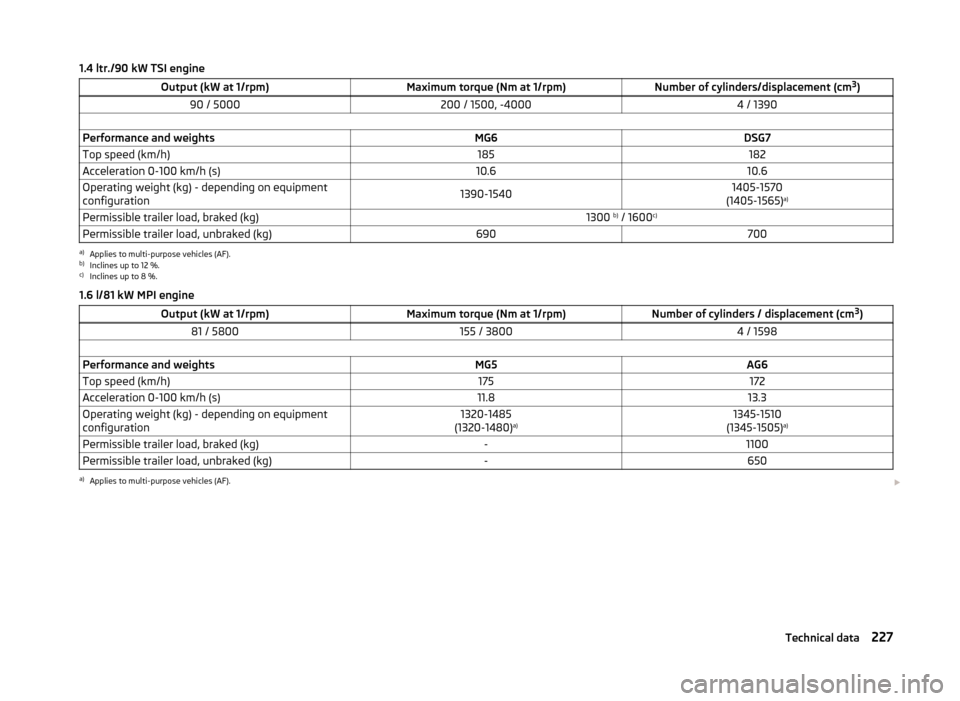
1.4 ltr./90 kW TSI engineOutput (kW at 1/rpm)Maximum torque (Nm at 1/rpm)Number of cylinders/displacement (cm3
)90 / 5000200 / 1500, -40004 / 1390 Performance and weightsMG6DSG7Top speed (km/h)185182Acceleration 0-100 km/h (s)10.610.6Operating weight (kg) - depending on equipment
configuration1390-15401405-1570
(1405-1565) a)Permissible trailer load, braked (kg)1300
b)
/ 1600 c)Permissible trailer load, unbraked (kg)690700a)
Applies to multi-purpose vehicles (AF).
b)
Inclines up to 12 %.
c)
Inclines up to 8 %.
1.6 l/81 kW MPI engine
Output (kW at 1/rpm)Maximum torque (Nm at 1/rpm)Number of cylinders / displacement (cm 3
)81 / 5800155 / 38004 / 1598 Performance and weightsMG5AG6Top speed (km/h)175172Acceleration 0-100 km/h (s)11.813.3Operating weight (kg) - depending on equipment
configuration1320-1485
(1320-1480) a)1345-1510
(1345-1505) a)Permissible trailer load, braked (kg)-1100Permissible trailer load, unbraked (kg)-650a)
Applies to multi-purpose vehicles (AF).
227Technical data